
Image 011241-03/04-01
Used between 1884 and 1902, blue underglaze.
In the year 1760 the candidate of theology Georg Heinrich Macheleidt, who was born 1723 in Cursdorf and had been living in Sitzendorf for a few years, received a concession from Prince Johann-Friedrich von Schwarzburg-Rudolstadt to establish a porcelain factory in Sitzendorf. After initial success, the whole factory was moved to the town of Volkstedt by order of the Prince just two years later. No marks were documented for this period; this business was also not affiliated with any of the later factories located in Sitzendorf.
Many years later, the landlord and resident of Sitzendorf Wilhelm Liebmann, born in the town of Lichte, was honoured with the permission of re-establishing a porcelain factory in Sitzendorf on November 18th 1850. The newly-founded business quickly earned a very good reputation, but only a few years after opening it was nearly completely destroyed in a terrible blaze which left only the kilns operational.
Together with the new partner Wilhelm Oertel as financial backer, Liebmann was able to quickly rebuild the factory, also acquiring a second mill in the process; at that time the number of employees also rose to around sixty. After a few successful years, both Liebmann and Oertel decided to retire, striking a deal with the businessman Alfred Voigt.
The factory was in 1884 taken over the brothers Alfred and Carl Wilhelm Voigt which changed the product range, starting with the introduction of lace figurines decorated in Meissen style. Business went very well and in 1890 enabled them to open a subsidiary in the town of Unterweißbach; both factories together gave work to 300 employees. In the same year, the town of Sitzendorf itself started to introduced its own electricity (110 Volts AC) which was generated via steam engine. This resulted in a large improvement of working conditions as all work during early morning and late evening hours up until then had to be done in the dull light of oil lamps. The Gebrüder Voigt company was one of four German factories which produced Kewpie figures, a design by US artist Rose O'Neill.
In 1896 the company was re-structured as limited company with a foundation stock of one million German Marks. The major shareholder of the company at that time was the secret councilor of commerce Albert Schönau who in 1902 also became responsible for the change in the company mark. Between 1899 and 1900 the railway line that connected Oberrottenbach and Katzhütte took up service and Sitzendorf finally received its own railway station.
During the same period, the factory was modernized and the kilns and other ovens were converted so that they were able to use coal instead of wood. These two independent facts resulted in cheaper production and transport which made the factory more competitive. It should be noted here that nearly all businessmen and factory owners of the Königsee district had been fighting for the railway line since 1872 as they had seen the possibilities that this new transportation method offered for the region.
The next years seemed quite promising but the disastrous effects of WWI followed later by the worldwide economoc crisis in the late twenties nearly ruined the company and so the Unterweißbach branch was closed in 1928. In the year 1932 the situation began to stabilize under the leadership of the former authorized representatives Reinhold Rebhan and Max Krauße which had become the new proprietors and that changed the name to a simple Sitzendorfer Porzellanmanufaktur AG.
From the beginning of the Second World War in 1939, nearly all workers were moved to factories concentrating on war-related production and export activities drastically decreased as the former customer countries had now of course become enemies. In the last months of 1944 the defence plant Prototyp-Werke Zell-Harmersbach was moved from the town of Bromberg over into the area of Thuringia and a part of it was relocated in small shacks in the yard of the Sitzendorfer Porzellanmanufaktur, producing defence related goods from October onwards.
Reinhold Rebhan retired as director in 1948 but the company remained in the hands of his son Rolf Rebhan who successfully continued to lead the company through the next years; one of the highlights during that period was the celebration of the 100 year factory anniversary in 1950. In 1958 the company was managed with government engagement as were most larger East German companies during that time. Due to the old fashioned production lines and the lack of skilled workers, productivity decreased more and more which resulted in a complete loss of competitiveness on the world market.
The factory was completely nationalized in the year 1972 and the still existing shacks in the yard that now contained a small tool factory were removed after this moved into the former gas works. The now vacant area was used to build a new production complex and in 1974 the complete porcelain production was converted to primary use electricity - people knowing the many advantages of gas fired kilns of course instantly twitch at this thought. But after that the East German state lost interest in the factory and over the next years, the factory slowly degraded as more and more urgently needed repairs and modernizations were simply ignored.
Directed by Rolf Rebhan's son-in-law Uwe Hermann (*1952-NOV-13), the very successful 135th anniversary celebrations went ahead in 1985. By then the East German state was not only drastically loosing ground politically; the financial situation of the whole state was catastrophic and the East German government slowly realized that large amounts of foreign currency would be needed to change the situation. As that could be easily earned by enabling the existing porcelain factories to work more efficiently, factories all over the country were adapted and modernized as the state leaders tried to make up for years of mismanagement.
For the Sitzendorf factory this process resulted in the construction of a representative sales room as well as an urgently needed mold storage, but the largest change was the conversion to gas fired kilns as this required the construction of an ugly but effective bridge across the Schwarza river in 1989 which reconnected the factory with the district gas mains.
After German reunification the factory was reprivatized and refounded as limited partnership on June 1st 1990 with Rolf Rebhan's daughter Carla Hermann as the complementary while her husband Uwe Hermann together with Mr. Hans-Jürgen Schmidt joined as limited partners. Based on the porcelain factory, a completely new business concept was developed together with the local tourist board. First step was the construction of a new sales room at the end of 1990. That was in 1992 followed by the reconstruction of the old dining hall which then housed the restaurant, named Schatztruhe ('Treasure Trove').
The old warehouse was refurbished in 1993, the result being a sales room for antique furniture and porcelain adornment which also allowed performance shows. The appartment of the former factory caretaker and some smaller store rooms directly next to the Schatztruhe were gutted in 1994, allowing expansion of the existing restaurant which was then divided into three seperate areas, Schatztruhe, Zum Rundofen and Pferdestall. The same year, a regional steam engine museum named Dampfmaschine was established on the premises; that alone had over 8,000 visitors between the day of the opening on June 29th until November 1st.
Sitzendorf as city in 1995 celebrated its 625th anniversary, the festivities falling together with those of the Porzellanfabrik Sitzendorf which celebrated its 145th birthday. Five years later, the factory proudly celebrated its 150th anniversary with many high class forms of entertainment, like a procession through the town of Sitzendorf which reflected the history of porcelain in the area by presenting the whole development in 24 themes.
One of the last big changes in Sitzendorf followed the new construction of the gas network in the town which resulted in a direct link from the factory to the new gas pipes via the main road; the ugly steel bridge that had bothered the citizens since 1989 was finally torn down. But that was only one side of the medal. As direct result of the overall market development, the company had to battle with steadily decreasing sales in the follwing years and thus adapted the number of employees accordingly.
Just over ten years later, the situation was dire. Press releases from August/September 2011 indicated that the company was trying to restructure its business, cutting back on figural porcelain even more. Uwe Hermann had previously tried to stabilize business by establishing a subsidiary, the Cottatherm Limited, a company which successfully introduced various ceramic products (food warmers, etc.) for hotel and gastronomy use under the trademark Cottatherm. It was planned that the Sitzendorf factory should continue to create figures whilst the subsidiary secured overall funding, but due to the financial situation and management errors, the Cottatherm Limited was eventually deleted from the trade register (August 3rd 2011, official publication of the Jena court).
The last effort to reposition the Sitzendorf brand and company failed and the factory including all assets was offered for auction. As nobody was interested, the business was put under official supervision in the last quarter of 2012. Production stopped in November 15th 2012, following the filing of an insolvency appeal. On March 23rd 2013 finally, proceedings were officially opened under order of the Gera court and I stopped following up on the matter.
In June 2018 I received an email via the account of Carla Hermann which had been signed off by general director Uwe Hermann. He claimed that the company "... had never ceased operation, had never been up for auction, and was still active ...", claiming that they had purchased it themselves. Looking at the copies of the legal paperwork, newspaper clippings, the DoveBid auction and screen captures stating otherwise I found his statements ridiculous. Not only had various newspapers also reported that there had been no production in 2013 and 2014 but Hermann himself had also stated that items were produced elsewhere in a newspaper interview from mid-2014. Per coincidence I even found out where exactly, as the Sitzendorf factory was listed as client reference.
Anyway, the Sitzendorf website was still present in January 2022. With publication date of March 22nd 2023 however, the trade register clearly shows that Uwe Hermann was no longer managing director, leaving his wife Carla Marie Elis Hermann in charge. During a website review on January 19th 2024, both the contact page and the imprint still claimed Uwe Hermann to be the responsible managing director. What appears to be a minor oversight is actually illegal under German law and I wonder how long this pseudo-factory will still be around.
Note that the crowned (sans-serif) "S" mark was used ever since 1918. In 1949, former united Germany split into East and West Germany and the factory in Sitzendorf applied for new registration at the East German trademark office on March 24th 1954. The 'new' registration was finally registered under №·605678 on April 30th 1955; that registration was renewed in 2004.

Image 011241-03/04-01
Used between 1884 and 1902, blue underglaze.
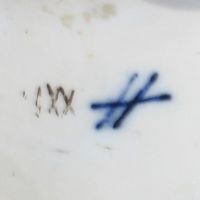
Image 011241-03/04-02
Used between 1884 and 1902, here with a cryptic 'VXX' addition.
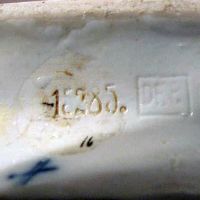
Image 011241-03/04-03
Used between 1884 and 1902, here accompanied by an impressed (and by then obsolete) DEP..
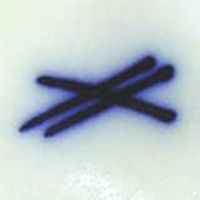
Image 011241-03/04-04
Used between 1884 and 1902, slightly different angles.
(Picture: Eric & Debbie)
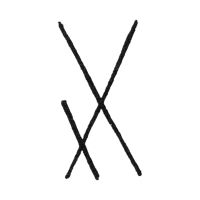
Image 011241-04-01
Used between 1900 and 1902, one of the parallel lines was significantly shorter than the other.
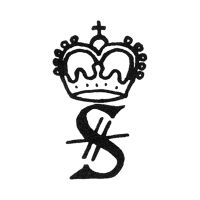
Image 011241-04-02
Used between 1902 and 1918, elaborate crown with hollow pearls above serifed 'S'.
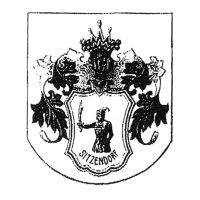
Image 011241-04-03
Used between 1915 and 1925. Registered at the RWZR under №·210·321 on May 17th 1916.
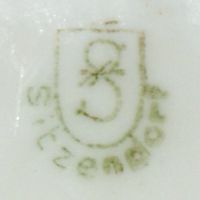
Image 011241-04/05-01
Used between 1916 and 1954,
(Picture: Lisa Phillips)
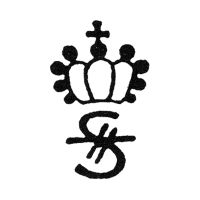
Image 011241-04/05/06-01
Used since 1918. East German trademark application on March 24th 1954, registered under №·605678 on April 30th 1955. Renewed in 2004.
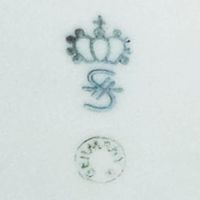
Image 011241-04/05/06-02
Used since 1918, additional "Germany" customs mark was used until around 1920.
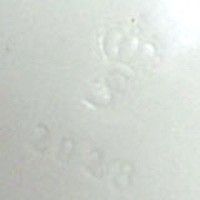
Image 011241-04/05/06-03
Used since 1918, impressed version.
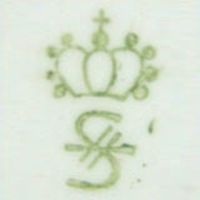
Image 011241-04/05/06-04
Used since 1918, example of a rarely found green version.
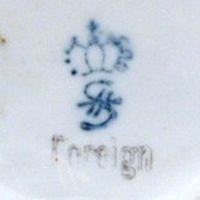
Image 011241-04/05/06-05
Used since 1918, here a special version for export to countries that turned down "Germany" marked items.
(Picture: Elio Germano)
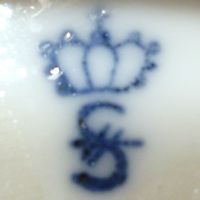
Image 011241-04/05/06-06
Used since 1918. Note that they normally did not include stamped East German country of origin designations from 1949 onwards.
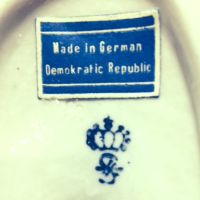
Image 011241-05/06-01
Used between 1949 and 1990, sticker with 'MADE IN GERMAN DEMOCRATIC REPUBLIC'.
(Picture: Jessica Johnson)
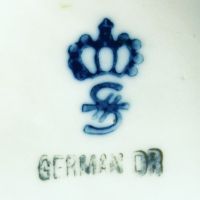
Image 011241-06-01
Rarely used stamped country of origin mark only used around 1972, 'GERMANY DR' (German Democratic Rebublic) addition.

Image 011241-07-01
Re-registered at the D.P.M.A. as №·39963063 on October 11th 1999, deleted November 1st 2009.
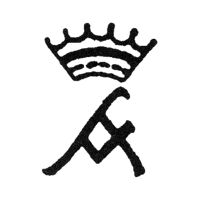
Image 011241-07-02
No error: Sitzendorf re-registered a former Ackermann & Fritze mark (D.P.M.A. №·30010257, used between February 2000 and March 2010).
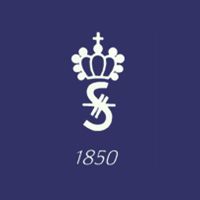
Image 011241-07-04
Company logo 2010.
© 2004-2026 C.S.Marshall, all rights reserved